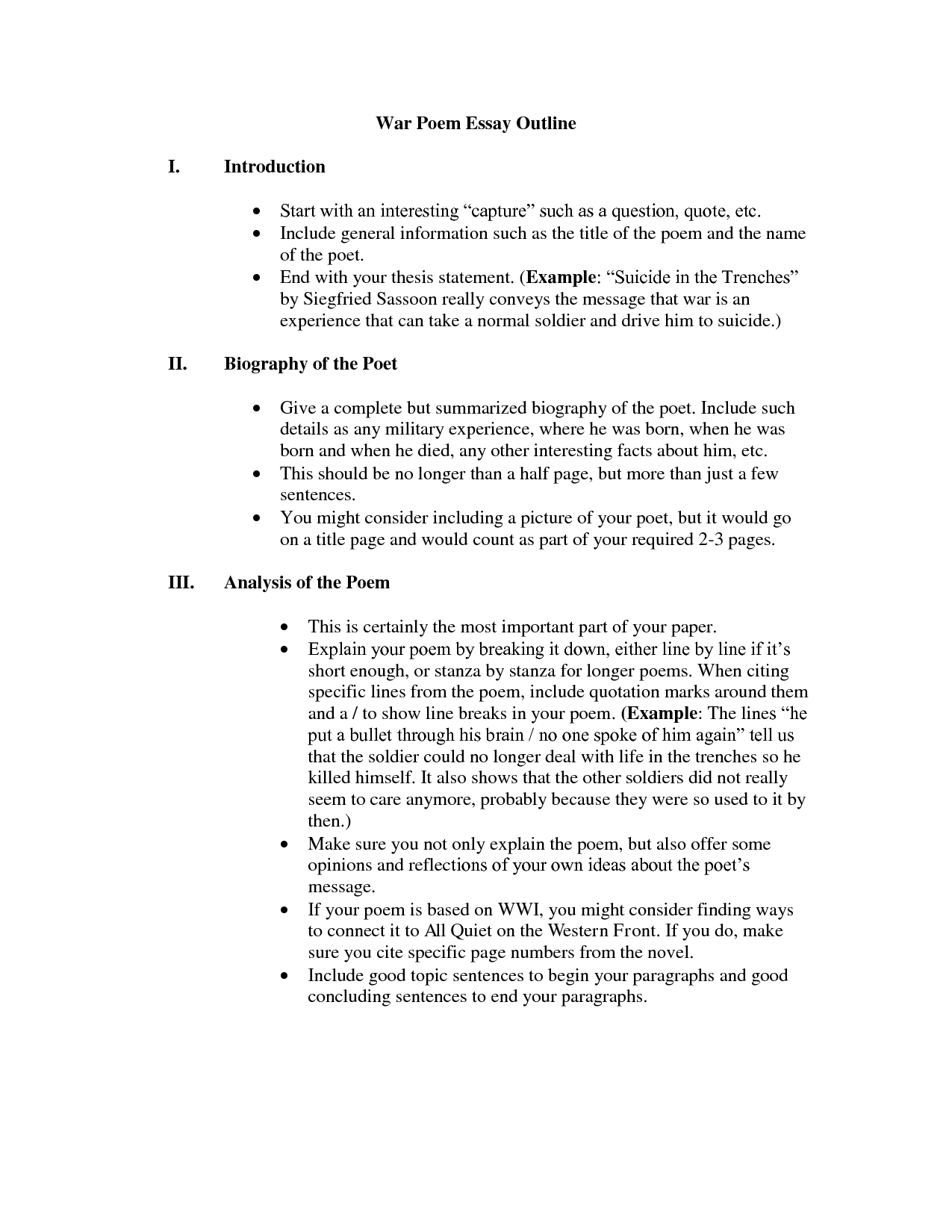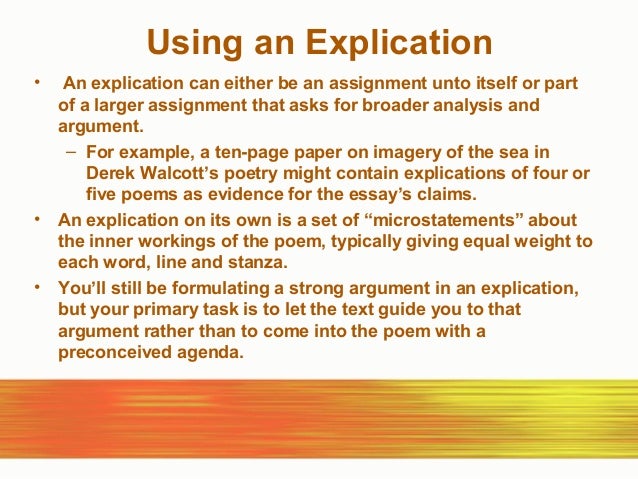
A poetry explication is a relatively short analysis which describes the possible meanings and relationships of the words, images, and other small units that make up a poem. Writing an explication is an effective way for a reader to connect a poem’s subject matter with its structural features. This handout reviews some of the important techniques of approaching and writing a poetry explication, and · A poetry explication is a relatively short analysis which describes the possible meanings and relationships of the words, images, and other small units that make up a poem. Writing an explication is an effective way for a reader to connect a poems plot and conflicts with its structural features. This can also be called a close reading of a poem Here is an outline of a poem analysis essay to use: Opening paragraph - Introduce the Poem, title, author and background. Body of text - Make most of the analysis, linking ideas and referencing to the poem. Conclusion - State one main idea, feelings and meanings. Poem Analysis Essay Introduction
Poetry Explication Instructions - Order Your Essay
Poetry Explications. What this handout is about. A poetry explication is a relatively short analysis which describes the possible meanings and relationships of the words, images, and other small units that make up a poem. Writing an explication is an effective way for a reader to connect a poem's plot and conflicts with its structural features. This handout reviews some of the important techniques of approaching and writing a poetry explication, and includes parts of two sample explications.
Preparing to write the explication. The large issues. Determine the basic design of the poem by considering the who, poetry explication essay, what, when, where, and why of the dramatic situation. What conflicts or themes does the poem present, address, or question?
What does the speaker say? Who is the audience? Are other characters involved? Consider the plot or basic design of the action.
How are the dramatized conflicts or themes introduced, sustained, resolved, etc.? Describe the physical location of the dramatic moment. The details, poetry explication essay. To analyze the design of the poem, we must focus on the poem's parts, namely how the poem dramatizes conflicts or ideas in language.
By concentrating on the parts, we develop our understanding of the poem's structure, and we gather support and evidence for our interpretations. Some of the details we should consider include the following:.
Does the poem present any unique variations from the traditional structure of that form? Does the rhetoric seem odd in any way? Consider the predicates and what they reveal about the speaker. Do any statements have convoluted or vague syntax? Do any of the words have multiple or archaic meanings that add other meanings to the line? Use the Oxford English Dictionary as a resource.
The patterns. As you analyze the design line by line, look for certain patterns to develop which provide insight into the dramatic situation, the speaker's state of mind, or the poet's use of details, poetry explication essay. Some of the most common patterns include the following:. Basic terms for talking about meter. Meter from the Greek metron, meaning measure refers principally to the recurrence of regular beats in a poetic line. In this way, meter pertains to the structure poetry explication essay the poem as it is written.
The most common form of meter in English verse since the 14th century is accentual-syllabic meter, poetry explication essay, in which the basic unit is the foot. The following are the four most common metrical feet in English poetry:. Note line 23 from Shelley's "Stanzas Written in Dejection, Near Naples":. Meter also refers to the number of feet in a line:. Monometer Dimeter Trimeter Tetrameter Pentameter Hexameter. one two three four five six.
Any number above six hexameter is heard as a combination of smaller parts; for example, what we might call poetry explication essay seven feet in a line is indistinguishable aurally from successive lines of tetrameter and trimeter To scan a line is to determine its metrical pattern.
Perhaps the best way to begin scanning a line is to mark the natural stresses on the polysyllabic words. Take Shelley's line:.
Then mark the monosyllabic nouns, verbs, adjectives, and adverbs that are normally stressed:. Then fill in the rest:, poetry explication essay. Then divide the line into feet:. Then note the sequence:. The line consists of four iambs; therefore, we identify the line as iambic tetrameter.
I got rhythm. Rhythm refers particularly to the way a line is voiced, i. Often, when a reader reads a line of verse, choices of stress and unstress poetry explication essay need to be made. For example, the first line of Keats' "Ode on Melancholy" presents the reader with a problem:. No, no, go not to Lethe, poetry explication essay, neither twist.
If we determine the regular pattern of beats the meter of this line, we will most likely identify the line as iambic pentameter. If we read the line this poetry explication essay, the statement takes on a musing, somewhat poetry explication essay tone. However, because the first five words are monosyllabic, we may choose to read the line differently. In fact, we may be tempted, poetry explication essay, especially when reading aloud, to stress the first two syllables equally, making the opening an emphatic, directive statement.
Note that monosyllabic words allow the meaning of the line to vary according to which words we choose to stress when reading i. The first line of Milton's Paradise Lost presents poetry explication essay different type of problem.
Of Man's First Disobedience, and the Fruit, poetry explication essay. Again, this line is predominantly iambic, but a problem occurs with the word Disobedience. If we read strictly by the meter, then we must fuse the last two syllables of the word. However, if we read the word normally, we have a breakage in the line's metrical structure.
In this way, the poet forges a tension between meter and rhythm: does the word remain contained by the structure, or do we choose to stretch the word out of the normal foot, thereby disobeying the structure in which it was made?
Such tension adds meaning to the poem by using meter and rhythm to poetry explication essay certain conflicts. In this example, Milton forges such a tension to present immediately the essential conflicts that lead to the fall of Adam and Eve.
Writing the explication. The explication should follow the same format as the preparation: begin with the large issues and basic design of the poem and work through each line to the more specific details and patterns. The first paragraph. The first paragraph should present the large issues; it poetry explication essay inform the reader which conflicts are dramatized and should describe the dramatic situation of the speaker.
The explication does not require a formal introductory paragraph; the writer should simply start explicating immediately. According to UNC 's Professor William Harmon, the foolproof way to begin any explication is with the following sentence: "This poem dramatizes the conflict between …" Such a beginning ensures that you will introduce the major conflict or theme in the poem and organize your explication accordingly.
Here is an example. A student's explication of Wordsworth's "Composed upon Westminster Bridge" might begin in the following way:, poetry explication essay. This poem dramatizes the conflict between poetry explication essay and reality, particularly as this conflict relates to what the speaker seems to say and what he really says. From Westminster Bridge, the speaker looks at London at sunrise, and he explains that all people should be struck by such a beautiful scene.
The speaker notes that the city is silent, and he points to several specific objects, naming them only in general terms: "Ships, towers, domes, poetry explication essay, theatres, and temples" 6.
After describing the "glittering" aspect of these objects, he asserts that these city places are just as beautiful in the morning as country places like "valley, rock, or hill" 8, Finally, after describing his deep feeling of calmness, the speaker notes how the "houses seem asleep" and that "all that mighty heart is lying still" 13, In this way, the speaker seems to say simply that London looks beautiful in the morning.
The next paragraphs. The next paragraphs should expand the discussion of the conflict by focusing on details of form, rhetoric, syntax, and vocabulary. In these paragraphs, the writer should explain poetry explication essay poem line by line in terms of these details, and he or she should incorporate important elements of rhyme, rhythm, and meter during this discussion. The student's explication continues with a topic sentence that directs the discussion of the first five lines:.
However, the poem begins with several oddities that suggest the speaker is saying more than what he seems to say initially. For example, poetry explication essay, the poem is an Italian sonnet and follows the abbaabbacdcdcd rhyme scheme. The fact that the poet chooses to write a sonnet about London in an Italian form suggests that what he says may not be actually praising the city.
Also, the rhetoric of the first two lines seems awkward compared to a normal speaking voice: "Earth has not anything to show more fair, poetry explication essay. Here, the city wears the poetry explication essay beauty, so it is not the city but the morning that is beautiful The conclusion??
The explication has no formal concluding paragraph; do not simply restate the main points of the introduction!
The end of the explication should focus on sound effects poetry explication essay visual patterns as the final element of asserting an explanation. Or, as does the undergraduate here, the writer may choose simply to stop poetry explication essay when he or she reaches the end of the poem:.
The poem ends with a vague statement: "And all that mighty heart is lying still! In this way, the poet reinforces the conflict between the appearance of the city in the morning and what such a scene and his words actually reveal. Tips to keep in mind.
Refer to the speaking voice in the poem as the speaker" or "the poet. Use the present tense when writing the explication. The poem, as a work of literature, continues to exist! To avoid unnecessary uses of the verb "to be" in your compositions, the following list suggests some verbs you can use when writing the explication:. dramatizes presents illustrates characterizes underlines.
How To Analyse A Poem
, time: 5:09Poetry Explications – The Writing Center • University of North Carolina at Chapel Hill

Here is an outline of a poem analysis essay to use: Opening paragraph - Introduce the Poem, title, author and background. Body of text - Make most of the analysis, linking ideas and referencing to the poem. Conclusion - State one main idea, feelings and meanings. Poem Analysis Essay Introduction A poetry explication is an analytical essay that comments on a poem’s elements and possible meanings. In other words, writers make connections between the narrative of the poem and the · A poetry explication is a relatively short analysis which describes the possible meanings and relationships of the words, images, and other small
No comments:
Post a Comment